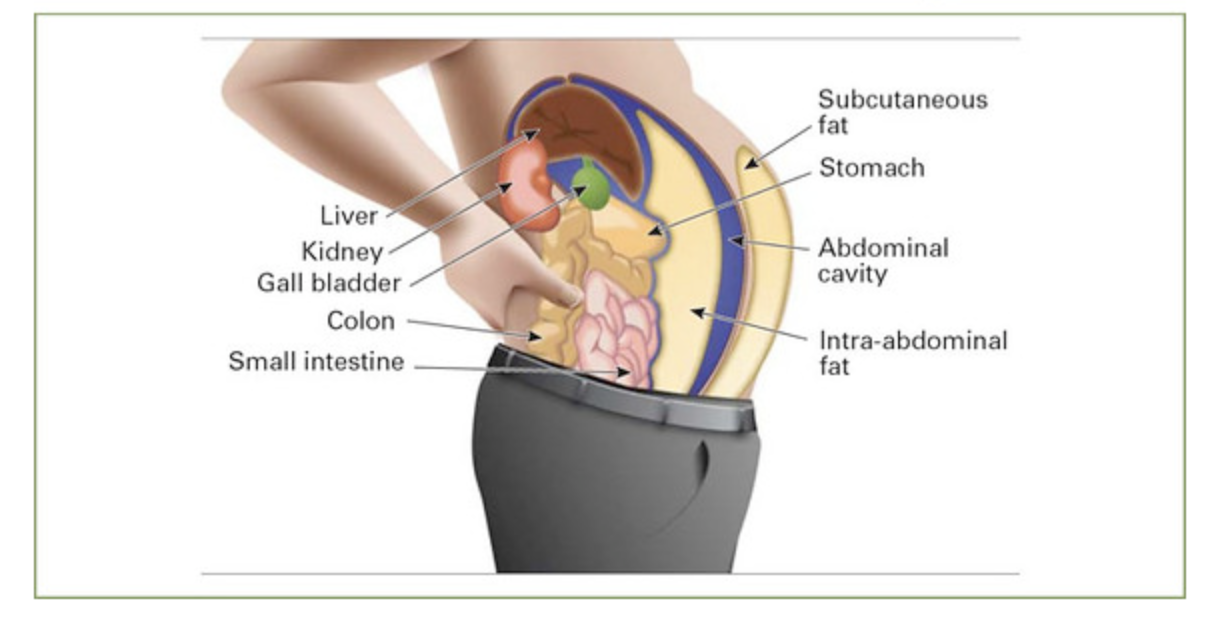Unit 5 – Lipids: Fats, Oils, and Cholesterol
5.4 The Functions of Lipids
Fats serve useful functions in both the body and the diet. In the body, fat functions as an important depot for energy storage, offers insulation and protection, and play an important role in cell membranes. Large amounts of dietary fat are not required to meet these functions, because most fat can be synthesized by the body from carbohydrate and protein (with the exception of two essential fatty acids). However, fat also plays unique roles in the diet, including increasing the absorption of fat-soluble vitamins and contributing to the flavor and satisfaction of food. Let’s take a closer look at each of these functions of fats in the body and in the diet.
The Functions of Fats in the Body
Storing Energy
Carbohydrates and fats provide most of the energy for our bodies. When we eat too much of either, the excess energy is stored as fat in adipose tissue. As discussed in the carbohydrates unit, glucose is stored attached to water in the muscles and liver as glycogen. Because glycogen has a high water content, the body cannot store much of it for long. Fats, on the other hand, can serve as a larger and more long-term energy reserve. Fats pack together tightly without water and store far greater amounts of energy in a reduced space. A fat gram is densely concentrated with energy, containing 9 kcal compared to the 4 kcal found in a gram of carbohydrate.
We draw on the energy stored in fat to help meet our basic energy needs, espeically for our muscles for physical activity such as walking to class, playing sports, dancing around the room, or powering through a workout at the gym. Historically, when humans relied on hunting and gathering wild foods, having the ability to store energy as fat was vital to survival through lean times. Hunger remains a problem for people around the world, and being able to store energy when times are good can help them endure a period of food insecurity. In other cases, the energy stored in adipose tissue might allow a person to weather a long illness.
Unlike other body cells that can store fat in limited supplies, fat cells (or adipocytes in Figure 5.16) are specialized for fat storage and are able to expand almost indefinitely in size. An overabundance of adipose tissue can be detrimental to your health not only from mechanical stress on the body due to excess weight, but also from hormonal and metabolic changes. Obesity can increase the risk for many diseases, including type 2 diabetes, heart disease, stroke, kidney disease, and certain types of cancer. It can also interfere with reproduction, cognitive function, and mood. Thus, while some body fat is critical to our survival and good health, too much is detrimental.

Insulating and Protecting
The average body fat for a man is 18 to 24 percent and for a woman is 25 to 31 percent[1], but adipose tissue can comprise a much larger percentage of body weight depending on the degree of obesity of the individual. Some of this fat is stored within the abdominal cavity, called visceral fat, and some is stored just underneath the skin, called subcutaneous fat. Visceral fat protects vital organs—such as the heart, kidneys, and liver. The blanket layer of subcutaneous fat insulates the body from extreme temperatures and helps keep the internal climate under control. It pads our hands and buttocks and prevents friction, as these areas frequently come in contact with hard surfaces. It also gives the body the extra padding required when engaging in physically demanding activities such as ice skating, horseback riding, or snowboarding.[2]

Regulating and Signaling
Fats help the body to produce and regulate hormones. For example, adipose tissue secretes the hormone leptin, which signals the body’s energy status and helps to regulate appetite. Fat is also required for reproductive health; a woman with very low body fat may stop menstruating and be unable to conceive until she gains weight and increases body fat. Omega-3 and omega-6 essential fatty acids help regulate cholesterol and blood clotting and control inflammation in the joints, tissues, and bloodstream. Fats are especially important to brain activity in structure and in function, helping to form nerve cell membranes, insulate neurons, and facilitate the signaling of electrical impulses throughout the brain. Fat is very important for infants to support the rapid brain growth during the first year of life.
The Function of Fats in Foods
Aiding Absorption and Increasing Bioavailability
The dietary fats in the foods we eat aid in the transport of fat-soluble vitamins, carrying them through the digestive process and improving their intestinal absorption. This improved absorption is known as increased bioavailability. Dietary fats can also increase the bioavailability of compounds known as phytochemicals—non-essential plant compounds considered beneficial to human health. Many phytochemicals are fat-soluble, such as lycopene found in tomatoes and beta-carotene found in carrots, so dietary fat improves the absorption of these molecules in the digestive tract.
In addition to improving bioavailability of fat-soluble vitamins, some of the best dietary sources of these vitamins are also foods that are high in fat. For example, good sources of vitamin E are nuts, seeds, and plant oils such as those found in salad dressings, and it’s difficult to consume enough vitamin E if you’re eating a very low-fat diet.
However, the vitamin E in fried foods cooked in vegetable oils is destroyed by the high heat used in cooking. So french fries or onion rings are not good sources of vitamin E. Vegetable oils also provide some vitamin K, and fatty fish and eggs are good sources of vitamins A and D.
Contributing to the Smell, Taste, and Satiety of Foods
 Fats satisfy appetite (the desire to eat) because they add flavor to foods. Fat contains dissolved compounds that contribute to mouth-watering aromas and flavors. Fat also adds texture, making baked foods moist and flakey, fried foods crispy, and adding creaminess to foods like ice cream and cream cheese. Consider fat-free cream cheese; when fat is removed from the cream, much of the flavor is also lost. As a result, it is grainy and flavorless—nothing like its full-fat counterpart—and many additives are used in an attempt to replace the lost flavor.
Fats satisfy appetite (the desire to eat) because they add flavor to foods. Fat contains dissolved compounds that contribute to mouth-watering aromas and flavors. Fat also adds texture, making baked foods moist and flakey, fried foods crispy, and adding creaminess to foods like ice cream and cream cheese. Consider fat-free cream cheese; when fat is removed from the cream, much of the flavor is also lost. As a result, it is grainy and flavorless—nothing like its full-fat counterpart—and many additives are used in an attempt to replace the lost flavor.
 Fats satisfy hunger (the need to eat) because they’re slower to be digested and absorbed than other macronutrients. Dietary fat thus contributes to satiety—the feeling of being satisfied or full. When fatty foods are swallowed, the body responds by enabling the processes controlling digestion to slow the movement of food along the digestive tract, giving fats more time to be digested and absorbed and promoting an overall sense of fullness. Sometimes, before the feeling of fullness arrives, people overindulge in fat-rich foods, finding the delectable taste irresistible. Slowing down to appreciate the taste and texture of foods can give your body time to send signals of satiety to your brain, so you can eat enough to be satisfied without feeling overly full.
Fats satisfy hunger (the need to eat) because they’re slower to be digested and absorbed than other macronutrients. Dietary fat thus contributes to satiety—the feeling of being satisfied or full. When fatty foods are swallowed, the body responds by enabling the processes controlling digestion to slow the movement of food along the digestive tract, giving fats more time to be digested and absorbed and promoting an overall sense of fullness. Sometimes, before the feeling of fullness arrives, people overindulge in fat-rich foods, finding the delectable taste irresistible. Slowing down to appreciate the taste and texture of foods can give your body time to send signals of satiety to your brain, so you can eat enough to be satisfied without feeling overly full.
Providing Essential Fatty Acids
Most lipid molecules can be synthesized in the body from other organic molecules, so they don’t specifically need to be provided in the diet. However, there are two that are considered essential and must be included in the diet: linoleic acid and alpha-linolenic acid. We’ll discuss these two fatty acids in detail later in the unit.
Review Questions
Attributions:
- Lane Community College’s Nutrition: Science and Everyday Application “Functions of Fats ” CC BY-NC 4.0
Images:
- Figure 5.3. “Adipose tissue, close-up showing adipocytes, SEM” by David Gregory & Debbie Marshall is licensed under CC BY 4.0
- Figure 5.4. “Pandemic of Lifestyle Disease” by Sandra Cohen-Rose and Colin Rose is licensed under CC-BY-2.0
- “French Fries in Paris” by Jim Larrison is licensed under CC BY 2.0
- “Eating a Burger Jonny B’z Dog and More Lourdie Dinner March 24, 20116” by Steven Depolo is licensed under CC-BY-2.0
- ACE (2009) What are the guidelines for percentage of body fat loss? American Council on Exercise (ACE). Ask the Expert Blog. December 2, 2009. ↵
- Obesity Prevention Source. Harvard T.H. Chan School of Public Health. Health Risks: Weight Problems Take a Hefty Toll on Body and Mind. Retrieved from: https://www.hsph.harvard.edu/obesity-prevention-source/obesity-consequences/health-effects/ ↵
Fat in the body
A red carotenoid found in tomatoes, watermelon, pink grapefruit, and papaya
The desire to eat

